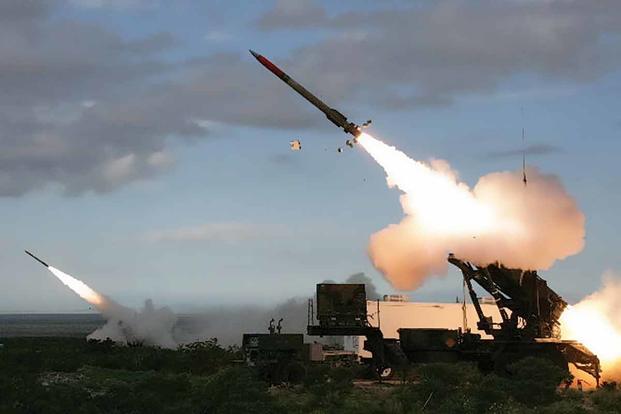The attack on two major Saudi oil plants by low-flying drones in September highlighted an emerging vulnerability of long-range missile defense systems: The attacking systems were able to evade Patriot PAC-2 surface-to-air missile batteries in order to reach their targets.
As the Army rebuilds short-range air defense capabilities, long deprioritized in favor of long-range systems, the service is also looking to integrate counter-drone capabilities into existing Patriot systems.
Specifically, it's building into the picture Raytheon's Howler counter-unmanned aerial systems configuration, which includes the Coyote "kamikaze drone," an expendable UAS that can locate and destroy enemy drones, and the Ku band radio frequency system multi-mission simultaneous radar, or KuRFS, which can acquire and track drones of all sizes.
The Army is already employing the Howler, which reached initial operational capability in June after a development and fielding window of just 17 months. The system is capable of intercepting Group 1 and Group 2 drones, including systems up to 55 pounds, capable of operating at altitudes of up to 3,500 feet.
Related: Attacks on Saudi Oil Plants Reveal Weaknesses in US-Made Defenses
It's part of a "Lego set" approach, where capabilities are built onto existing systems to meet consumer needs, said John Hobday, head of business development for Coyote and Rapid Development Programs at Raytheon Missile Systems.
"You need detection in depth, and defense in depth, because if you face a threat like the Saudis did with the recent attack that they underwent, the further out that you can detect the threats and engage them, the less chance that you're going to suffer as much damage [with] the leakers that start coming through," he told Military.com at the Association of the United States Army's annual meeting in Washington, D.C.
Cliff Johnson, director of Tactical Radar business development for Raytheon Integrated Defense Systems, said integrating the Howler with the Patriot doesn't just add defense capabilities, but also creates a further layer of protection for the larger system.
"So we'll have a Howler system to defeat any of those small [unmanned aerial vehicles] that may want to be a kamikaze type of a missile into the Patriot system itself. So that's a classic piece of how we're integrating and keeping that layered air defense and counter-UAS architecture together to protect the protector," he said.
Hobday noted that combining the two systems is also cost-effective.
"You don't want to shoot a Patriot at a small UAV, because that's an important asset to take on a much more complex target," he said. "So that's why the Army came to us with this counter-UAS problem, and they said, 'Hey, Patriot's great for what it does. But we have to deal now with this new emerging target, and we need to do it in a cost-effective way and we have to do it quickly."
Raytheon has completed acceptance testing for the Block 2 Coyote, which will have better sensors and rocket motors, allowing it to be more maneuverable in carrying out the mission. Delivery will begin in February or March, the company said.
Johnson said the systems have had the capability to integrate for less than a year, although he couldn't speak to where or how the Army has been employing the interfacing systems. He also could not say whether Howler integration is in planning with the additional Patriot systems the Pentagon is deploying to Saudi Arabia in the wake of the oil plant attacks.
"I would suspect the Army is looking at all avenues of capability to place in-country," he said.
Meanwhile, the Howler system is on its way to being cleared for foreign military sales.
"We already have countries that are talking to us because, especially in the Middle East ... it's a critical requirement for them," Hobday said. "So we're working directly through the Army for foreign military sales."
Pending congressional approval, he said, those sales could begin as early as 2021.
-- Hope Hodge Seck can be reached at hope.seck@military.com. Follow her on Twitter at @HopeSeck.
Read more: Having Penis Transplant Was 'One of the Best Decisions I Ever Made,' Navy Veteran Says













